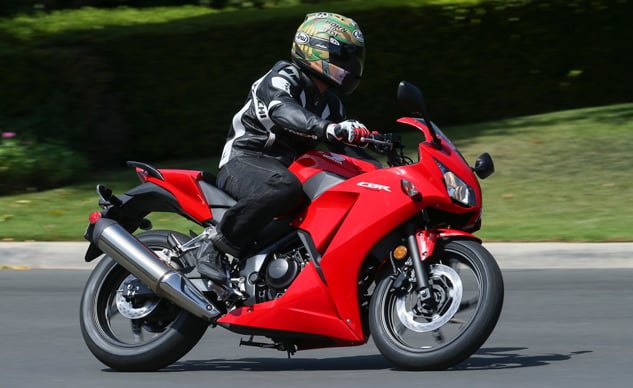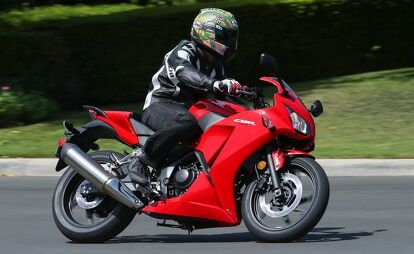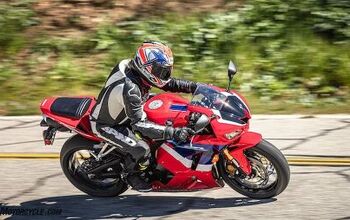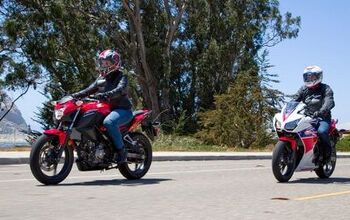2015 Honda CBR300R First Ride Review

When the Honda CBR250R came on the scene in late 2010 as a 2011 model, it seemed like the perfect challenger to the beginner sportbike king, the twin-cylinder Kawasaki Ninja 250, which, for a couple of decades, was basically the de facto choice for new sport-minded riders looking to get into motorcycling. Finally, there was another option for those who wanted something different. However, simply playing catch-up wasn’t enough. Kawasaki then fuel-injected the little Ninja and made it a 300, leaving the single-cylinder CBR reeling. Not one to back down from a challenge, Honda has come fighting back with the new CBR300R.
Baby Bump
2015 Honda CBR300R
| Engine | 17.5/20 |
| Suspension/Handling | 11.0/15 |
| Transmission/Clutch | 7.5/10 |
| Brakes | 7.0/10 |
| Instruments/Controls | 4.0/5 |
| Ergonomics/Comfort | 8.0/10 |
| Appearance/Quality | 8.5/10 |
| Desirability | 8.5/10 |
| Value | 9.0/10 |
| Overall Score | 81/100 |
Here’s the rub: As the name would imply, the 300R’s single-cylinder engine is the same as its predecessor, only increasing in size to 286cc, 37cc more than the CBR250R, but still 10cc less than the Ninja 300’s parallel-Twin. Calling the new CBR a 300 does seem a little generous in this case, but admittedly, “CBR286R” just doesn’t roll off the tongue the same way. The bump in displacement is a result of increasing the Thumper’s stroke from 55mm to 63mm. Its 76mm bore stays the same. Honda says this provides a 17% boost in horsepower. Using the 22.5 hp our CBR250R put down in our 2013 Beginner Sportbike Shootout, this means we can hope to see around 26 horses to the wheel from the 300R. Torque, too, should get a healthy bump as well, but Honda didn’t give any numbers.
Obviously, the big news here is the bigger engine size, but Honda didn’t stop there when morphing the 250 into the 300. EFI tuning has been revised to help modulate the extra power. If you’re a newer rider reading this, don’t worry about its throttle response being unruly. Really, we couldn’t think of anything to nag about with the previous version anyway.
Being a part of the CBR family, the 300 was styled to better mimic its bigger brothers: the CBR500R, CBR600RR and CBR1000RR, mainly. The dual headlights resemble that of the CBR lineup, as do the stylized curves of the bodywork. Weirdly, the CBR250R took its styling cues from the VFR1200. To me, the bike looks much better than before, even tricking me at first glance into thinking it was one of the bigger CBRs in the lineup. I’ve spoken to new riders who moved up in displacement category from the quarter-liter class because of the bike’s looks. Personally, I dig the 300R’s CBR-inspired look. So much so, if I owned one, I’d likely hang on to it for a while.
As a part of these styling tweaks, the profile of the 300 is now slimmer. Seat height is actually a smidge taller on the 300, sitting at 30.7 inches, 0.2 inch taller than before, but a narrower seat/tank juncture and slim side covers makes flat-footing easy. If 30.7 inches still sounds too intimidating, Honda offers an accessory saddle, dropping seat height an entire inch. The same 357-pound curb weight as before makes the baby CBR incredibly easy to maneuver, whether you’re picking it up off the sidestand, moving it around the garage or changing direction on the road.
A crucial, yet sometimes overlooked aspect of the new riding experience is also learning how to maintain your motorcycle. Honda has made this easier on the 300R by making key components more accessible. Bodywork, like the fuel tank and side covers, is now easier to remove, and a change in engine mounting points gives easier access to the spark plug, oil filter, valves and rear brake reservoir.
CB300F
While Honda assembled its invited media guests to its headquarters in Torrance, CA, to sample the new CBR300R, it also had on display one of the first CB300F models on these shores, fresh from the manufacturing facilities in Thailand, where both it and the CBR300R are made. Essentially a naked version of the 300R, the F model on display sheds much of the bodywork, replaces the clip-ons for handlebars, swaps dual headlights for a single headlamp unit, and comes in nine pounds lighter than the 300R (348 lbs). It will retail at $400 less than the $4,399 300R. Riding one wasn’t allowed, but sitting on it revealed a comfortable, upright seating position and a toy-like lightness. Unfortunately, without spinning a wheel on one, that’s about the most I can say about it.
First Ride
Approaching this ride from a new rider’s point of view, I thought back to my first bike, a Yamaha FZR600. Call me a hypocrite for not starting off with a 250 after spouting off the values of the quarter-liter class, but I was young and dumb. Still, the deal was too good to pass up. Riding the CBR300R reminded me how terrible a decision I made buying that beat-up, old FZR. Simply hopping aboard the Honda, the narrowness of the chassis is instantly noticed. Its slim waistline meant my stubby 30-inch inseam had zero problems getting both feet firmly on the floor.
Turn the key, thumb the starter, and the Single braaps to life, settling into a smooth idle thanks to its electronic fuel injection. Pull on the light clutch, click into gear and the CBR is able to roll away with a slow release of the left hand, no throttle needed. Once rolling with any real purpose, one will notice the little Honda is geared rather short in the first three gears; shifts from first to second happen between 15 – 20 mph. The bike lulls along nicely in city traffic, and its bump in power over its predecessor is especially noticed when trying to pass another vehicle. With more air to suck, squeeze, bang and blow, there’s more oomph on tap to satisfy a more experienced rider, but by no means is it going to spook the newb learning about throttle control.
The CBR really hits its stride around 5000 rpm, but considering our ride route didn’t include any freeway action, it’s difficult to comment on its highway manners. In our experience, the 250R was nearly tapped out managing 80 mph on the highway. The 300R’s additional power and taller final-drive gearing (a fairly significant 5.6%: 2.571 vs. 2.714, respectively) likely will result in greater speed headroom to keep up with freeway traffic, despite the 300R’s slightly shorter transmission ratios.
The twisty portion of our ride was thrown a curveball, as unexpected road construction killed the best part of the journey. All was not lost, however, as alternative curvy roads were found, and here the CBR shows its pedigree. It takes a small input to initiate a turn, but the 300R holds its line well, and with its paltry size, it’s incredibly easy to change direction.
This is certainly no thoroughbred racebike like the CBR600RR or CBR1000RR, and it shows with its softly-sprung dampers. While there’s a growing racing scene for the quarter-liter class, experienced folks will outride the 300R’s suspenders rather quickly (should racetrack antics be your thing). For newer riders, the budget suspension provides a good learning tool to becoming smooth while progressively picking up speed.
Brakes, too, are adequate, but certainly not incredible. The single 296mm front disc and two-piston caliper benefits from the added stopping power from the rear 220mm disc. Still, a good squeeze is required to get meaningful stopping power out of them. Antilock brakes are a $500 option available on all CBR300R color schemes. Personally, choosing ABS should be a no-brainer for new riders, as it allows them to learn brake modulation with minimal penalties for going too far. Thankfully, the front and rear brakes are not linked.
Watch Out Ninjas
Ultimately, Honda’s CBR300R is a clear step up in speed compared to the model it replaces. The performance upgrade is plenty for almost any situation, and the narrowness and feather-like stature of the bike will make any new rider comfortable almost immediately. At $4,399, it won’t break the bank, and it will provide a solid foundation to hone your skills. Honda even says it’ll return 71 mpg, meaning you can spend less time at the gas station and more time riding. Isn’t that the point?
Time will tell if Honda has brought enough to unseat the mighty Kawasaki Ninja 300 in the beginner bike wars, but the CBR only narrowly lost out when we last pitted the two (and the Hyosung GT250R) against each other. Honda’s hoping the 300R’s surge in power, combined with less weight than the Kawi (357 lbs. vs. 379 lbs., respectively) and a lower price tag ($4399 vs. $4999, respectively) will be what it takes to push it over the top.
Stay tuned, as, to use the boxing analogy, we’re gathering the two contenders for a superlightweight bout.

Troy's been riding motorcycles and writing about them since 2006, getting his start at Rider Magazine. From there, he moved to Sport Rider Magazine before finally landing at Motorcycle.com in 2011. A lifelong gearhead who didn't fully immerse himself in motorcycles until his teenage years, Troy's interests have always been in technology, performance, and going fast. Naturally, racing was the perfect avenue to combine all three. Troy has been racing nearly as long as he's been riding and has competed at the AMA national level. He's also won multiple club races throughout the country, culminating in a Utah Sport Bike Association championship in 2011. He has been invited as a guest instructor for the Yamaha Champions Riding School, and when he's not out riding, he's either wrenching on bikes or watching MotoGP.
More by Troy Siahaan




















































































Comments
Join the conversation
The 300 Ninja and Ktm390 will eat the Cbr300 alive
Th